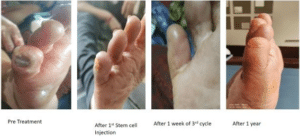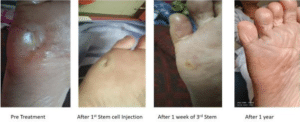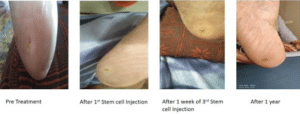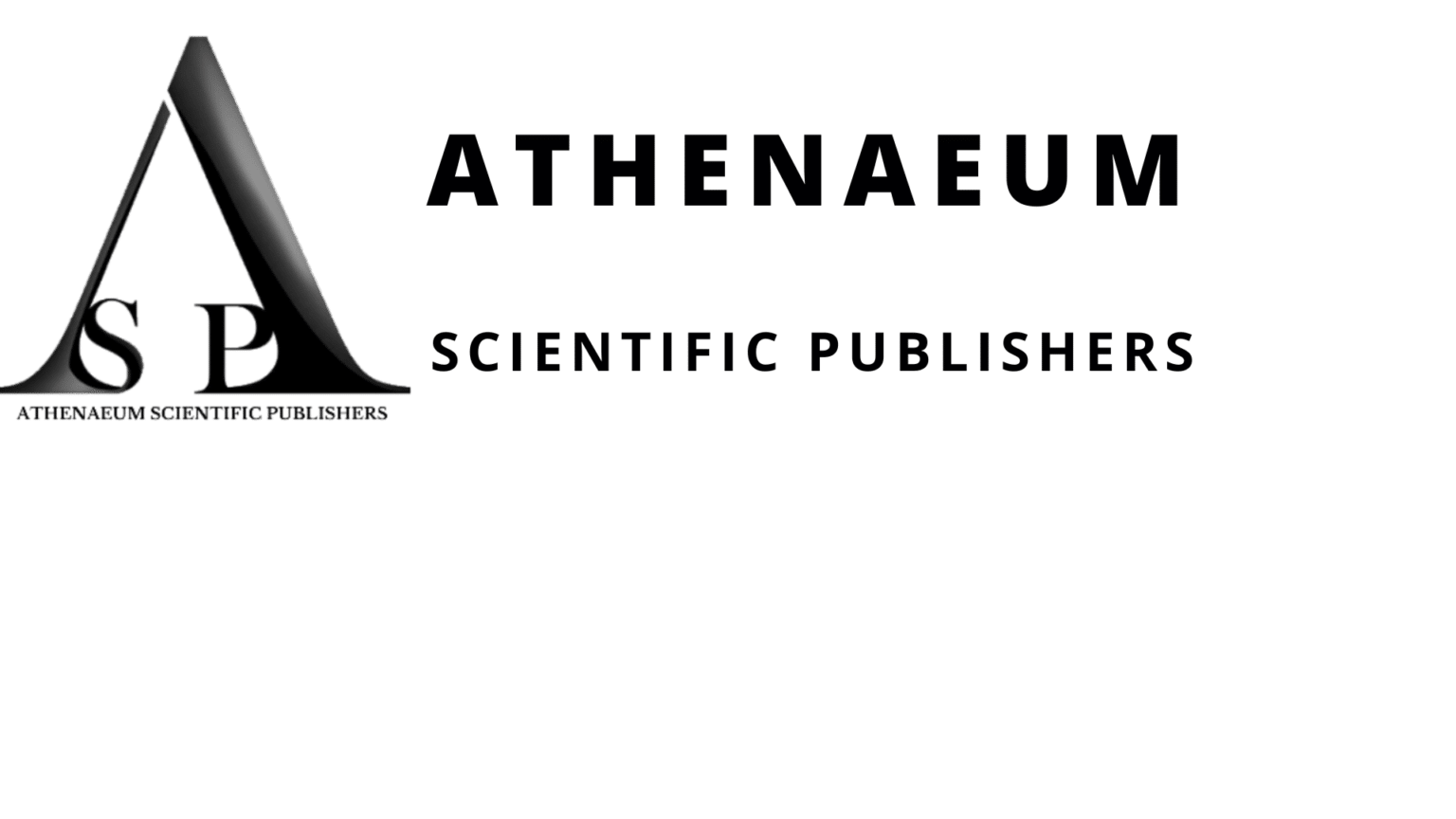Megha Patel1, Ankur Patel1, Prashant Kshatriya1*
1Senior Scientist, Viecell Institute of Regenerative Medicine Surat, India
*Correspondence author: Prashant Kshatriya, Senior Scientist, Viecell Institute of Regenerative Medicine Surat, India; Email: [email protected]
Published Date: 04-10-2023
Copyright© 2023 by Kshatriya P, et al. All rights reserved. This is an open access article distributed under the terms of the Creative Commons Attribution License, which permits unrestricted use, distribution, and reproduction in any medium, provided the original author and source are credited.
Abstract
We treated a patient with progressive, refractory scleroderma with multiple ulcers on her feet with a combination of intravenous and a subcutaneous injection at the periphery of the ulcers using Umbilical Cord-Derived Mesenchymal Stem Cells (UCMSCs). The patient improved subjectively and objectively and we have followed up with the patient for 1 year. The combination was well tolerated and effective, suggesting a large-scale study may be warranted for progressive, refractory scleroderma ulcer treatment.
Keywords: Mesenchymal Stem Cells (MSCs); Scleroderma; Ulcer
Introduction
The word “scleroderma” means hardening of skin and that is the most visible symptom of the complaint [1,2]. Scleroderma is an autoimmune disease whose etiology remains unknown affecting the connective tissues, characterized by vascular complaint which further leads to increased collagen and extracellular matrix deposit, fibrotic concession, ulcer and inflammation of the skin and affects internal organs like lungs, digestive tract, blood vessel, heart [3]. All these symptoms are responsible for increased morbidity and lead to functional disability (like reduced mouth opening and loss of hand function), pain and cerebral consequences. This impacts not only the patient’s quality of life but also reduces his life expectation. In at least half of the cases, patient will die from Systemic Sclerosis (SSc)- related diseases and the other half from advanced prevalence of malice and cardiovascular conditions compared to the general population [4,5]. There’s no restorative treatment to date. Only characteristic treatments are generally proposed to patients to palliate pain and ameliorate function. New remedial strategies are being imaged among which Mesenchymal Stem Cells (MSCs) grounded remedy, which is presently under evaluation in the conventions.
Properties of Mesenchymal Stem Cells (MSCs)
MSCs are adult multipotent progenitor cells, which have been first isolated from bone marrow [5]. In addition to bone marrow derived MSCs (BM-MSCs) now they have been isolated from several tissues, including Adipose Tissue (ASCs), umbilical cord (UC-MSCs), placenta (PD-MSCs) or dental pulp [6]. MSCs are defined by 3 criteria, as proposed by the International Society for Cell Therapy: (a) plastic adherence, (b) the positive cell surface markers CD73, CD90, CD105 and lack of expression of the hematopoietic markers CD34, CD45, HLA-DR and (c) capacity of differentiation into adipocytes, chondrocytes and osteoblasts [7]. Along with their potential of multilineage differentiation, MSCs shows several paracrine functions like they support survival and differentiation of hematopoietic stem cells, induce cell proliferation and have anti-fibrotic, antiapoptotic, pro-angiogenic, anti-bacterial and anti-inflammatory effects [8]. Although MSCs from different tissue sources share similar properties, they may display some differences in their immunomodulatory capacity or differentiation potential [9,10].
Mechanism of mesenchymal stem cells in counteracting scleroderma symptoms
MSCs are proposed to play important roles in several diseases via different mechanisms of action, in which various mediators are also secreted through each of these mechanisms [12,13]:
- The anti-fibrotic property prevents collagen accumulation in the skin, lung and digestive system [12,14]
- The angiogenic properties go against widespread vasculopathy by using Vascular Endothelial Growth Factor (VEGF), Insulin-Like Growth Factor-1 (IGF-1), HGF, Platelet-Derived Growth Factor (PDGF) and IL6 [12,14]
- The anti-inflammatory property counteracts the dysregulation of the immune system. TGFβ1, IL6, Prostaglandin E2 (PGE2), HGF, Interferon-Gamma (IFN-γ), IL- 10, IL4, Tumor Necrosis Factor alpha (TNF-α), Glucocorticoid-Induced Leucine Zipper (GILZ), Indolamine-2,3-Dioxygenase (IDO) and inducible NO Synthase (iNOS) are associated with this mechanism [15-18]
Method
The patient had their complaint verified by at rheumatologists. The stem cell injection procedures were fully explained. Patient had inked written informed consent. Umbilical Cords (UCs) were used as a source of the allogenic MSCs. The UCs were used within 2 h of delivery. The cords are cleaned with 70% alcohol also washed completely with saline and digested mechanically and enzymatically with collagenase I under sterile conditions. The dissolved cord was gathered and suspended in the growth medium. The digested cord was placed in 6-well plates and dressed in Dulbecco’s Modified Eagle’s Medium (DMEM) (Sigma, Germany), supplemented with 10 (v/ v) Fetal/ Bovine Serum (FBS) (Sigma, Germany), 2 mM L- glutamine, 100 U/ mL penicillin, 100 mg/ mL streptomycin and 1 µg/ mL amphotericin B (Lonza, Belgium). The culture plate was placed in an incubator with impregnated moisture at 5% CO2 at 37 ℃. The medium was changed doubly weekly till 80% confluency was reached. The cells were detached with trypsin, counted and seeded in vented tissue culture flask (Corning, USA) until passage [4]. Eventually, the cells were detached, counted and washed and suspended in the normal saline for intravenous infusion. A stem cell injection was given on the fringe of ulcer subcutaneously using insulin hype. The 3 cycles are given at the interval of 30 days (Fig. 1-4).

Figure 1: Thumb ulceration due to scleroderma.

Figure 2: Little toe ulceration due to scleroderma.

Figure 3: Metatarsal head ulceration due to scleroderma.

Figure 4: Heel ulceration due to scleroderma.
Patient Follow-up
We observed a reduction in necrotic skin after the first mesenchymal stem- cell infusion and a farther reduction and the presence of granulation towel and bleeding after the alternate and third infusions (Fig. 1-4). Sluggishly nearly the whole ulcer gets healed. There’s no history of rush after 1 time follow up. The overall skin of fritters had also shown enhancement before which was rigid and tight.
Discussion
In this patient with scleroderma, our intravenous infusion of expanded, autologous, umbilical cord-derived mesenchymal stem cells and subcutaneous injections on the periphery of ulcers substantially reduced skin necrosis. The results and the expression of angiogenic factors in regenerating tissues also suggest that mesenchymal stem cells promoted new vessel formation and vascular remodeling of the foot toe. Angiopoietins and vascular endothelial growth factor are both involved in angiogenesis and new vessel maturation and mesenchymal stem cells have been shown to promote angiogenesis through the up regulation of both in an experimental model of wound healing [19]. MSCs are believed to be non-reactive or very reactive, even when given in an allogeneic manner. This idea simulates a natural immune alteration that may possibly reset the immune system and reboot it [20,21]. Our case had aggressive, refractory and debilitating scleroderma that reached a level of irreversible progression and necrotic multiple ulcers on the feet. She benefited from stem cell therapy. The improvement in their symptoms has significantly shown resolution of pain, more mobility, less fatigue and dyspnea on mild exertion and above all, more freedom to do what they like.
The positive results of mesenchymal stem-cell infusion in graft-versus-host disease have fostered a growing interest in the potential therapeutic application of mesenchymal stem cells in autoimmune diseases [22]. Mesenchymal stem cells have also shown improved cardiac function through angiogenesis and myogenesis in experimental models of myocardial infarction and dilated cardiomyopathy [23]. Evidence shows that mesenchymal stem cells were not directly incorporated into the injured vasculature, which suggests that their protective and regenerative actions might be mediated by paracrine effects [24]. Researchers had found a reduction in both the number and size of treatment-resistant digital ulcers and nail-bed neovascularization with the intramuscular injection of autologous bone marrow-derived mononuclear cells into the ischemic limbs of patients with systemic sclerosis [25]. In our case, the injected mesenchymal stem cells regenerated the vascular network and reduced skin necrosis without adverse effects, possibly because mesenchymal stem cells can differentiate into endothelial and vascular smooth-muscle cells in ischemic microenvironments and induce the formation of new blood vessels [25,26]. We believe that the MSCs probably worked through immune modulation to balance the perturbed cytokine and growth factor soup in scleroderma, adjust the immune cellular balance, abate the ongoing fibrosis in scleroderma and therefore change the course of the disease. Stem cell therapy is not ready for use on every patient with scleroderma, but there are reasons to believe that it is possibly effective where there is indeed no hope to offer. Future large-scale studies can bring more scientific evidence to further improve this approach and fulfil the unmet needs to treat advanced scleroderma patients.
Conclusion
The present patient had scleroderma with complicating leg ulcers that were refractory to conventional immunosuppressive therapy, including adalimumab and etanercept for 4 years. Within 2 months of initiating MSC infusions, both scleroderma-associated foot ulcers and other scleroderma-associated lesions showed marked, continuous improvement. The patient’s foot ulcer did not reoccur even after one year of follow-up. Our experience suggests that MSC infusion might be a potentially successful therapy for intractable, drug-resistant scleroderma patients with concomitant foot ulcers.
Conflict of Interest
The authors have no conflict of interest to declare.
Informed Consent
Written informed consent was obtained from the patient for publication of this manuscript and any accompanying images. The study is approved by internal IEC.
References
- Gabrielli A, Avvedimento EV, Krieg T. Scleroderma. New Eng J Medicine. 2009;360(19):1989-2003.
- Nihtyanova SI, Denton CP. Autoantibodies as predictive tools in systemic sclerosis. Nature Rev Rheumatol. 2010;6(2):112-6.
- Allanore Y, Simms R, Distler O, Trojanowska M, Pope J, Denton CP, et al. Systemic sclerosis. Nat Rev Dis Primers. 2015;(1):15002
- Elhai M, Meune C, Boubaya M, Avouac J, Hachulla E, Balbir-Gurman A, et al. Mapping and predicting mortality from systemic sclerosis. Ann Rheumatic Dis. 2017;76(11):1897-905.
- Zeineddine N, El Khoury L, Mosak J. Systemic sclerosis and malignancy: a review of current data. J Clin Med Res. 2016;8(9):625.
- Friedenstein AJ, Gorskaja JF, Kulagina N. Fibroblast precursors in normal and irradiated mouse hematopoietic organs. Exp Hematol. 1976;4(5):267-74.
- Meirelles LD, Chagastelles PC, Nardi NB. Mesenchymal stem cells reside in virtually all post-natal organs and tissues. J Cell Science. 2006;119(11):2204-13.
- Dominici ML, Le Blanc K, Mueller I, Slaper-Cortenbach I, Marini FC, Krause DS, et al. Minimal criteria for defining multipotent mesenchymal stromal cells. The International Society for Cellular Therapy position statement. Cytotherapy. 2006;8(4):315-7.
- Maumus M, Jorgensen C, Noël D. Mesenchymal stem cells in regenerative medicine applied to rheumatic diseases: role of secretome and exosomes. Biochimie. 2013;95(12):2229-34.
- Kern S, Eichler H, Stoeve J, Klüter H, Bieback K. Comparative analysis of mesenchymal stem cells from bone marrow, umbilical cord blood, or adipose tissue. Stem Cells. 2006;24(5):1294-301.
- Keyser KA, Beagles KE, Kiem HP. Comparison of mesenchymal stem cells from different tissues to suppress T-cell activation. Cell Transplantation. 2007;16(5):555-62.
- Rozier P, Maria A, Goulabchand R, Jorgensen C, Guilpain P, Noël D. Mesenchymal stem cells in systemic sclerosis: allogenic or autologous approaches for therapeutic use? Frontiers Immunol. 2018;14(9):2938.
- Maumus M, Jorgensen C, Noël D. Mesenchymal stem cells in regenerative medicine applied to rheumatic diseases: role of secretome and exosomes. Biochimie. 2013;95(12):2229-34.
- Velier M, Simoncini S, Abellan M, Francois P, Eap S, Lagrange A, et al. Adipose-derived stem cells from systemic sclerosis patients maintain pro-angiogenic and antifibrotic paracrine effects in-vitro. J Clin Med. 2019;8(11):1979.
- Rozier P, Maria A, Goulabchand R, Jorgensen C, Guilpain P, Noël D. Mesenchymal stem cells in systemic sclerosis: allogenic or autologous approaches for therapeutic use? Frontiers Immunol. 2018;9:29-38.
- Cras A, Farge D, Carmoi T, Lataillade JJ, Wang DD, Sun L. Update on mesenchymal stem cell-based therapy in lupus and scleroderma. Arthritis Res Ther. 2015;17(1):1-9.
- Maria AT, Maumus M, Le Quellec A, Jorgensen C, Noël D, Guilpain P. Adipose-derived mesenchymal stem cells in autoimmune disorders: state of the art and perspectives for systemic sclerosis. Clinical Rev AllergyImmunol. 2017;52:234-59.
- Peltzer J, Aletti M, Frescaline N, Busson E, Lataillade JJ, Martinaud C. Mesenchymal stromal cells-based therapy in systemic sclerosis: rational and challenges. Frontiers Immunol. 2018;9:2013.
- Wu Y, Chen L, Scott PG, Tredget EE. Mesenchymal stem cells enhance wound healing through differentiation and angiogenesis. Stem Cells. 2007;25(10):2648-59.
- Krampera M, Glennie S, Dyson J, Scott D, Laylor R, Simpson E, et al. Bone marrow mesenchymal stem cells inhibit the response of naive and memory antigen-specific T cells to their cognate peptide. Blood: J American Society of Hematology. 2003;101(9):3722-9.
- Klyushnenkova E, Mosca JD, McIntosh KR. Human mesenchymal stem cells suppress allogeneic T-cell responses in-vitro: Implications for allogeneic transplantation. Blood. 1998;92(10):642A.
- Passweg J, Tyndall A. Autologous stem cell transplantation in autoimmune diseases. InSeminars in Hematol. 2007;44(4):278-85.
- Nagaya N, Fujii T, Iwase T, Ohgushi H, Itoh T, Uematsu M, et al. Intravenous administration of mesenchymal stem cells improves cardiac function in rats with acute myocardial infarction through angiogenesis and myogenesis. Am J Physiology-Heart and Circulatory Physiol. 2004;287(6):H2670-6.
- Waterman RS, Tomchuck SL, Henkle SL, Betancourt AM. A new Mesenchymal Stem Cell (MSC) paradigm: polarization into a pro-inflammatory MSC1 or an Immunosuppressive MSC2 phenotype. PloS One. 2010;5(4):e10088.
- Le Blanc K, Tammik C, Rosendahl K, Zetterberg E, Ringdén O. HLA expression and immunologic properties of differentiated and undifferentiated mesenchymal stem cells. Experimental Hematol. 2003;31(10):890-6.
- Ishigatsubo Y, Ihata A, Kobayashi H, Hama M, Kirino Y, Ueda A, et al. Therapeutic angiogenesis in patients with systemic sclerosis by autologous transplantation of bone-marrow-derived cells. Modern Rheumatol. 2010;20(3):263-72.
Article Type
Case Report
Publication History
Received Date: 23-08-2023
Accepted Date: 26-09-2023
Published Date: 04-10-2023
Copyright© 2023 by Kshatriya P, et al. All rights reserved. This is an open access article distributed under the terms of the Creative Commons Attribution License, which permits unrestricted use, distribution, and reproduction in any medium, provided the original author and source are credited.
Citation: Kshatriya P, et al. Subcutaneous and Intravenous Administration of Human Umbilical Cord Mesenchymal Stem Cells in Patient With Multiple Foot Ulcers Complicated by Scleroderma- A Case Report with One Year Follow Up. J Reg Med Biol Res. 2023;4(3):1-6.

Figure 1: Thumb ulceration due to scleroderma.

Figure 2: Little toe ulceration due to scleroderma.

Figure 3: Metatarsal head ulceration due to scleroderma.

Figure 4: Heel ulceration due to scleroderma.


